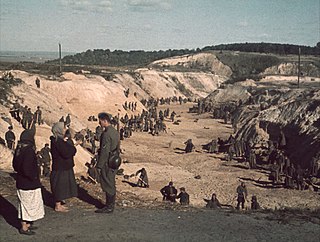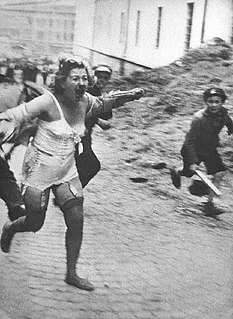 W
WBabi Yar is a ravine in the Ukrainian capital Kyiv and a site of massacres carried out by Nazi Germany's forces during its campaign against the Soviet Union in World War II. The first and best documented of the massacres took place on 29–30 September 1941, killing approximately 33,771 Jews. The decision to kill all the Jews in Kyiv was made by the military governor Generalmajor Kurt Eberhard, the Police Commander for Army Group South, SS-Obergruppenführer Friedrich Jeckeln, and the Einsatzgruppe C Commander Otto Rasch. Sonderkommando 4a troops, along with the aid of the SD and SS Police Battalions with the Ukrainian Auxiliary Police backed by the Wehrmacht, carried out the orders.
 W
WBabi Yar is a ravine in the Ukrainian capital Kyiv and a site of massacres carried out by Nazi Germany's forces during its campaign against the Soviet Union in World War II. The first and best documented of the massacres took place on 29–30 September 1941, killing approximately 33,771 Jews. The decision to kill all the Jews in Kyiv was made by the military governor Generalmajor Kurt Eberhard, the Police Commander for Army Group South, SS-Obergruppenführer Friedrich Jeckeln, and the Einsatzgruppe C Commander Otto Rasch. Sonderkommando 4a troops, along with the aid of the SD and SS Police Battalions with the Ukrainian Auxiliary Police backed by the Wehrmacht, carried out the orders.
 W
WThe Bila Tserkva massacre was the World War II mass murder of Jews, committed by the Nazi German Einsatzgruppe with the aid of Ukrainian auxiliaries, in Bila Tserkva, Soviet Ukraine, on August 21–22, 1941. When the Jewish adult population of Bila Tserkva was killed, several functionaries complained that some 90 Jewish children were left behind in an abandoned building, and had to be executed separately. The soldiers reported the matter to four chaplains of the Wehrmacht, who passed along their protests to Field Marshal von Reichenau; it was the only time during World War II that Wehrmacht chaplains tried to prevent an Einsatzgruppen massacre, but Paul Blobel's verbal order was direct and decisive.
 W
WThe Kamianets-Podilskyi massacre was a World War II mass shooting of Jews carried out in the opening stages of Operation Barbarossa, by the German Police Battalion 320 along with Friedrich Jeckeln's Einsatzgruppen, the Hungarian soldiers, and the Ukrainian Auxiliary Police. The killings were conducted on August 27 and August 28, 1941, in the Soviet city of Kamianets-Podilskyi, occupied by German troops in the previous month on July 11, 1941. According to the Nazi German reports a total of 23,600 Jews were murdered, including 16,000 who had earlier been expelled from Hungary.
 W
WThe Lviv pogroms were the consecutive pogroms and massacres of Jews in June and July 1941 in the city of Lwów in Eastern Poland/Western Ukraine. The massacres were perpetrated by Ukrainian nationalists, German death squads, and urban population from 30 June to 2 July, and from 25 to 29 July, during the German invasion of the Soviet Union. Thousands of Jews were killed both in the pogroms and in the Einsatzgruppen killings.
 W
WIn July 1941, 25 Polish academics from the city of Lwów along with their families were killed by Nazi German occupation forces. By targeting prominent citizens and intellectuals for elimination, the Nazis hoped to prevent anti-Nazi activity and to weaken the resolve of the Polish resistance movement. According to an eyewitness the executions were carried out by an Einsatzgruppe unit under the command of Karl Eberhard Schöngarth with the participation of Ukrainian translators in German uniforms.
 W
WThe Odessa massacre was the mass murder of the Jewish population of Odessa and surrounding towns in the Transnistria Governorate during the autumn of 1941 and the winter of 1942 while it was under Romanian control.